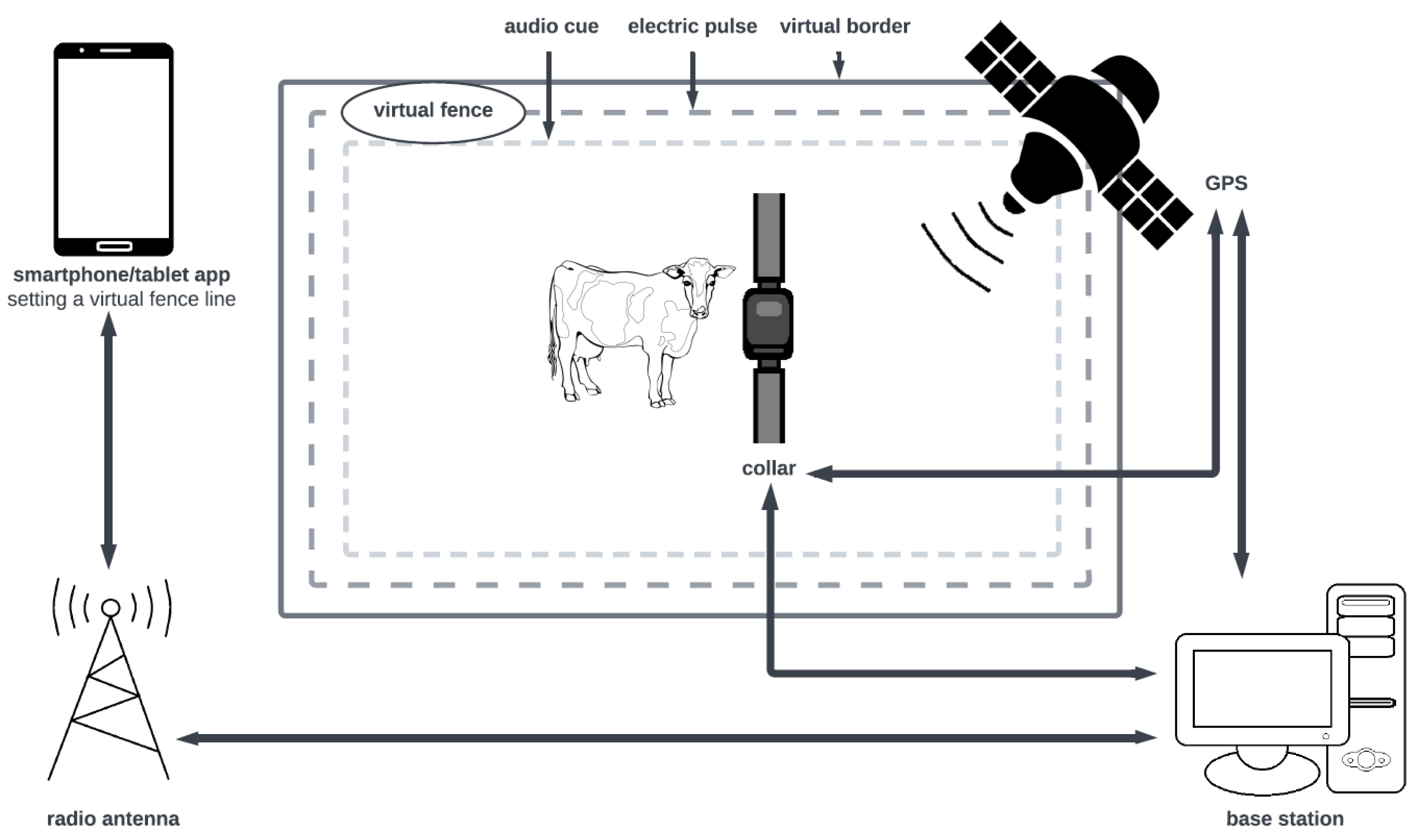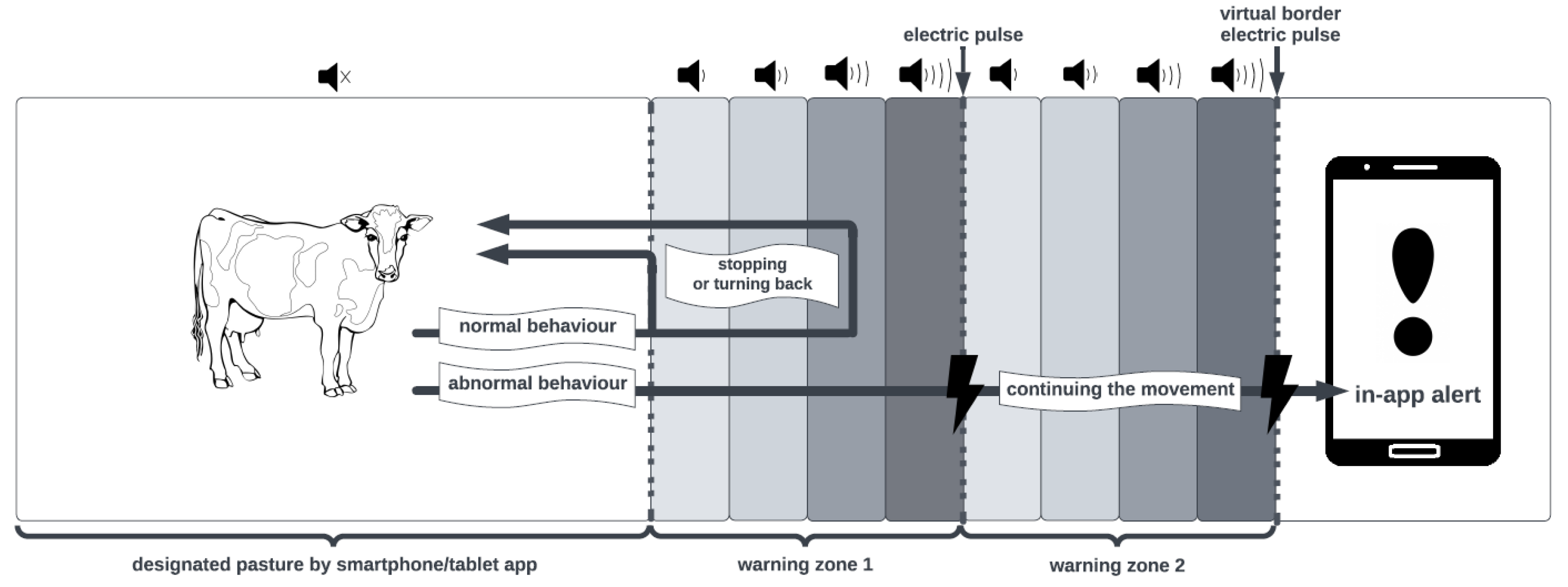
| Version | Summary | Created by | Modification | Content Size | Created at | Operation |
|---|---|---|---|---|---|---|
| 1 | Piotr Goliński | -- | 2398 | 2023-02-23 20:30:27 | | | |
| 2 | Lindsay Dong | Meta information modification | 2398 | 2023-02-27 03:16:43 | | |
Video Upload Options
Maximizing annual pasture consumption without negatively impacting individual cow performance is of great importance in grass-based dairy and beef systems due to pasture being the most cost-effective nutrient source. However, the disadvantages of conventional and electric fencing include material and labor costs and increased manual labor. Virtual fencing has been developed and evaluated for almost two decades. The evolution of precision livestock farming, specifically virtual fencing, presents new opportunities for maximizing the utilization of available pasture land. Virtual fencing technology decreases the labor involved in physical fencing, provides greater adaptability to changes in pasture conditions, increases precision and efficiency, and offers additional flexibility in grazing management practices. However, that innovative technology should be further developed, and improvements should include decreasing the total costs of the system and increasing its application to other technological groups of ruminants, e.g., suckler cows with calves, increasing the efficiency of the system operation in large areas and a larger number of animals.
1. Virtual Fencing for Grazing Animals


2. Innovative Systems of Virtual Fencing
Analysis of global patent databases revealed several solutions based on virtual pasture fencing technology using IoT. The first ideas regarding using audible signals emitted by a collar-mounted device worn by an animal appeared around half a century ago but did not initially apply to livestock. The primary purpose of such systems was to control the behavior of companion animals (dogs and cats) with audible signals to discourage them from approaching or passing through the existing fence. Peck [24] turned the concept of virtual fencing into reality with his patent (December 1973, USA) describing a method and apparatus for controlling animals. Later in 1987, Peck’s Invisible Fence manufactured the first virtual control devices for domestic livestock in the United States [7].
2.1. eShepherd
2.2. Nofence
2.3. Vence
2.4. Halter
3. Conclusions
References
- Cadero, A.; Aubry, A.; Dourmad, J.Y.; Salaun, Y.; Garcia-Launay, F. Towards a decision support tool with an individual-based model of a pig fattening unit. Comput. Electron. Agric. 2018, 147, 44–50.
- Berckmans, D. General introduction to precision livestock farming. Anim. Front. 2017, 7, 6–11.
- Roche, J.R.; Berry, D.P.; Bryant, A.M.; Burke, C.R.; Butler, S.T.; Dillon, P.G.; Donaghy, D.J.; Horan, B.; Macdonald, K.A.; Macmillan, K.L. A 100-year review: A century of change in temperate grazing dairy systems. J. Dairy Sci. 2017, 100, 10189–10233.
- Klootwijk, C.W.; Hulshof, G.; de Boer, I.J.M.; van den Pol-Van Dasselaar, A.; Engel, B.; van Middelaar, C.E. Correcting fresh grass allowance for rejected patches due to excreta in intensive grazing systems for dairy cows. J. Dairy Sci. 2019, 102, 10451–10459.
- Colusso, P.I.; Clark, C.E.F.; Green, A.C.; Lomax, S. The effect of a restricted feed ration on dairy cow response to containment from feed using a virtual fence. Front. Anim. Sci. 2021, 2, 710648.
- Stevens, D.R.; Thompson, B.R.; Johnson, P.; Welten, B.; Meenken, E.; Bryant, J. Integrating digital technologies to aid grassland productivity and sustainability. Front. Sustain. Food Syst. 2021, 5, 602350.
- Fay, P.K.; McElligott, V.T.; Havstad, K.M. Containment of free-ranging goats using pulsed-radio-wave-activated shock collars. Appl. Anim. Behav. Sci. 1989, 23, 165–171.
- Umstatter, C. The evolution of virtual fences: A review. Comput. Electron. Agr. 2011, 75, 10–22.
- Anderson, D.M. Virtual fencing—Past, present and future. Rangel. J. 2007, 29, 65–78.
- Anderson, D.M.; Estell, R.E.; Holechek, J.L.; Ivey, S.; Smith, G.B. Virtual herding for flexible livestock management—A review. Rangel. J. 2014, 36, 205–221.
- Monod, M.O.; Faure, P.; Moiroux, L.; Rameau, P. Stakeless fencing for mountain pastures. J. Farm Manag. 2009, 13, 697–704.
- Umstatter, C.; Brocklehurst, S.; Ross, D.W.; Haskell, M.J. Can the location of cattle be managed using broadcast audio cues? Appl. Anim. Behav. Sci. 2013, 147, 34–42.
- Greenwood, P.L. Review: An overview of beef production from pasture and feedlot globally, as demand for beef and the need for sustainable practices increase. Animal 2021, 15, 100295.
- Eastwood, C.; Ayre, M.; Nettle, R.; Rue, B.D. Making sense in the cloud: Farm advisory services in a smart farming future. NJAS Wagening. J. Life Sci. 2019, 90, 100298.
- Talavera, J.M.; Tobon, L.E.; Gomez, J.A.; Culman, M.A.; Aranda, J.M.; Parra, D.T.; Quiroz, L.A.; Hoyos, A.; Garreta, L.E. Review of IoT applications in agroindustry and environmental fields. Comput. Electron. Agric. 2017, 142, 283–297.
- Dhanaraju, M.; Chenniappan, P.; Ramalingam, K.; Pazhanivelan, S.; Kaliaperumal, R. Smart Farming: Internet of Things (IoT) Based Sustainable Agriculture. Agriculture 2022, 12, 1745.
- Wolfert, S.; Isakhanyan, G. Sustainable agriculture by the Internet of Things—A practitioner’s approach to monitor sustainability progress. Comput. Electron. Agric. 2022, 200, 107226.
- Lee, C.; Henshall, J.M.; Wark, T.J.; Crossman, C.C.; Reed, M.T.; Brewer, H.G.; O’Grady, J.; Fisher, A.D. Associative learning by cattle to enable effective and ethical virtual fences. Appl. Anim. Behav. Sci. 2009, 119, 15–22.
- González, L.A.; Bishop-Hurley, G.; Henry, D.; Charmley, E. Wireless sensor networks to study, monitor and manage cattle in grazing systems. Anim. Prod. Sci. 2014, 54, 1687–1693.
- Rahman, A.; Smith, D.V.; Little, B.; Ingham, A.B.; Greenwood, P.L.; Bishop-Hurley, G.J. Cattle behavior classification from the collar, halter, and ear tag sensors. Inf. Process. Agric. 2018, 5, 124–133.
- Halachmi, I.; Guarino, M.; Bewley, J.; Pastell, M. Smart animal agriculture: Application of real-time sensors to improve animal well-being and production. Annu. Rev. Anim. Biosci. 2019, 7, 403–425.
- Greenwood, P.L.; Paull, D.R.; McNally, J.; Kalinowski, T.; Ebert, D.; Little, B.; Smith, D.V.; Rahman, A.; Valencia, P.; Ingham, A.B.; et al. Use of sensor-determined behaviors to develop algorithms for pasture intake by individual grazing cattle. Crop Pasture Sci. 2017, 68, 1091–1099.
- Hanrahan, L.; Geoghegan, A.; O’Donovan, M.; Griffith, V.; Ruelle, E.; Wallace, M.; Shalloo, L. Pasture Base Ireland: A grassland decision support system and national database. Comput. Electron. Agric. 2017, 136, 193–201.
- Peck, R.M. Method and Apparatus for Controlling an Animal. U.S. Patent No. 3,753,421, 21 October 1973.
- Lee, C.; Prayaga, K.; Reed, M.; Henshall, J. Methods of training cattle to avoid a location using electrical cues. Appl. Anim. Behav. Sci. 2007, 108, 229–238.
- Lee, C. An Apparatus and Method for the Virtual Fencing of an Animal. International Patent Application No. PCT/AUT2005/001056, 26 January 2006.
- Lee, C.; Reed, M.T.; Wark, T.; Crossman, C.; Valencia, P. Control Device, and Method, for Controlling the Location of an Animal. International Patent Application No. PCT/AU2009/000943, 28 January 2010.
- Vaintrub, M.O.; Levit, H.; Chincarini, M.; Fusaro, I.; Giammarco, M.; Vignola, G. Review: Precision livestock farming, automats, and new technologies: Possible applications in extensive dairy sheep farming. Animal 2021, 15, 100143.
- Lee, C.; Fisher, A.D.; Reed, M.T.; Henshall, J.M. The effect of low energy electric shock on cortisol, beta-endorphin, heart rate and behavior of cattle. Appl. Anim. Behav. Sci. 2008, 113, 32–42.
- Verdon, M.; Lee, C.; Marini, D.; Rawnsley, R. Pre-exposure to an electrical stimulus prime associative pairing of audio and electrical stimuli for dairy heifers in a virtual fencing feed attractant trial. Animals 2020, 10, 217.
- Langworthy, A.D.; Verdon, M.; Freeman, M.J.; Corkrey, R.; Hills, J.L.; Rawnsley, R.P. Virtual fencing technology to intensively graze lactating dairy cattle. I: Technology efficacy and pasture utilization. J. Dairy Sci. 2021, 104, 7071–7083.
- Lomax, S.; Colusso, P.; Clark, C.E.F. Does virtual fencing work for grazing dairy cattle? Animals 2019, 9, 429.
- Lee, C.; Colditz, I.G.; Campbell, D.L.M. A framework to assess the impact of new animal management technologies on welfare: A case study of virtual fencing. Front. Vet. Sci. 2018, 5, 187.
- Official Website of Gallagher Company. Available online: www.am.gallagher.com (accessed on 10 October 2022).
- Campbell, D.L.M.; Haynes, S.J.; Lea, J.M.; Farrer, W.J.; Lee, C. Temporary exclusion of cattle from a riparian zone using virtual fencing technology. Animals 2019, 9, 5.
- Brunberg, E.I.; Bergslid, I.K.; Bøe, K.E.; Sørheim, K.M. The Ability of Ewes with Lambs to Learn a Virtual Fencing System. Animal 2017, 11, 2045–2050.
- Aaser, M.F.; Staahltoft, S.K.; Korsgaard, A.H.; Trige-Esbensen, A.; Alstrup, A.K.O.; Sonne, C.; Pertoldi, C.; Bruhn, D.; Frikke, J.; Linder, A.C. Is virtual fencing an effective way of enclosing cattle? Personality, herd behaviour and welfare. Animals 2022, 12, 842.
- Official Website of Nofence Company. Available online: www.nofence.no/en (accessed on 10 October 2022).
- Hamidi, D.; Komainda, M.; Tonn, B.; Harbers, J.; Grinnell, N.; Isselstein, J. The Effect of Grazing Intensity and Sward Heterogeneity on the Movement Behavior of Suckler Cows on Semi-Natural Grassland. Front. Vet. Sci. 2022, 8, 639096.
- Hamidi, D.; Grinnell, N.A.; Komainda, M.; Riesch, F.; Horn, J.; Ammer, S.; Traulsen, I.; Palme, R.; Hamidi, M.; Isselstein, J. Heifers don’t care: No evidence of negative impact on animal welfare of growing heifers when using virtual fences compared to physical fences for grazing. Animal 2022, 16, 100614.
- Official Website of Vence Company. Available online: https://vence.io (accessed on 10 October 2022).
- Boyd, C.S.; O’Connor, R.; Ranches, J.; Bohnert, D.W.; Bates, J.D.; Johnson, D.D.; Davies, K.W.; Parker, T.; Doherty, K.E. Virtual fencing effectively excludes cattle from burned sagebrush steppe. Rangel. Ecol. Manag. 2022, 81, 55–62.
- Boyd, C.S.; O’Connor, R.; Ranches, J.; Bohnert, D.W.; Bates, J.D.; Johnson, D.D.; Davies, K.W.; Parker, T.; Doherty, K.E. Using Virtual Fencing to Create Fuel Breaks in the Sagebrush Steppe. Rangel. Ecol. Manag. 2022.
- Official Website of South Dakota Public Broadcasting. Available online: www.listen.sdpb.org (accessed on 20 December 2022).
- Bishop-Hurley, G.J.; Swain, D.L.; Anderson, D.M.; Sikka, P.; Crossman, C.; Corke, P. Virtual fencing applications: Implementing and testing an automated cattle control system. Comput. Electr. Agric. 2007, 56, 14–22.
- Official Website of Halter Company. Available online: www.halterhq.com (accessed on 10 October 2022).




